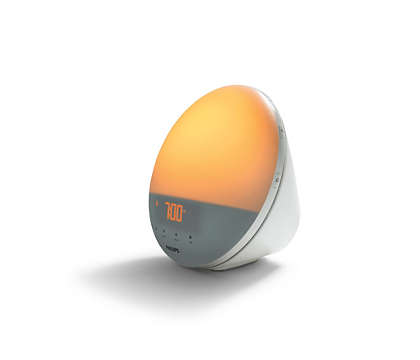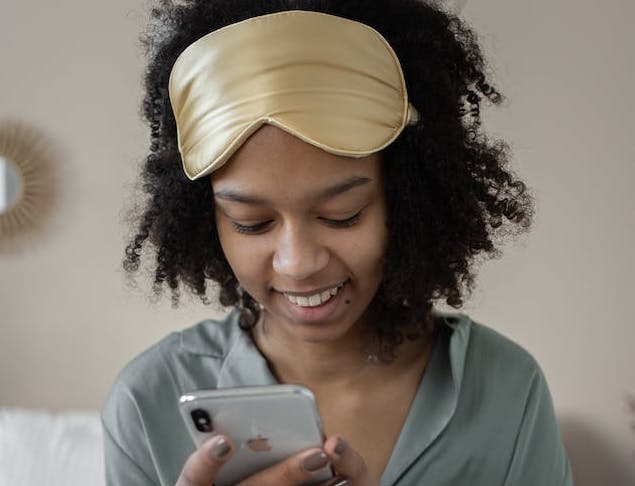Has your morning alarm ever jolted you awake?
Alarms trigger involuntary spikes in adrenaline, heart rate, and blood pressure.
Not only do these spikes start your morning off on the wrong foot – they may be bad for your health in the long term.
Who wants to hear a loud, deafening noise first thing in the morning?
If you often awake confused and panicked due to your alarm, you may achieve a more pleasant morning with a sunrise alarm clock.
Sunrise alarm clocks provide a gentle wake-up that simultaneously sets your circadian rhythm up for success.
Light’s Effect on Sleep-Wake Cues
Light has a powerful effect on our circadian rhythm, or sleep-wake cues.
In the daytime, sunlight leads to feelings of alertness and wakefulness. In contrast, the absence of light signals to the mind and body that it’s time to fall asleep.
Without adequate sunlight during the day, the brain may think it’s time to wind down.
In contrast, too much light from electronics at night disrupts the production of the sleep hormone melatonin, making it hard to fall asleep.
Therefore, it’s important to limit light exposure at night while increasing light exposure during the morning hours.
Viewing bright light first thing in the morning sends signals to the brain to hold off on melatonin production.
@somnifix Experts recommend direct morning sunlight exposure within 1 to 2 hours of waking to boost evening #melatonin production & improve #circadianrhythm ♬ Microwave Popcorn - Bo Burnham
Once you’re in a dark environment later in the day, your eyes then send a signal to the brain to begin making melatonin. As a result, you’ll feel tired and drift off easier.
Sunrise alarm clocks help you set your day up for success by significantly increasing alertness without any startling sounds first thing in the morning.
Moreover, they get gradually brighter to ease you into wakefulness rather than jolting you from a deep sleep.
We’ve rounded up the best options, starting with a viral sensation.
1. Trending Online: Hatch Restore
The Hatch Restore sunrise alarm has recently gained traction online as a popular alternative to a traditional alarm clock.
It’s more than just a sunrise alarm clock – it also doubles as a sound machine, nightlight, reading light, and meditation app.
Therefore, it’s more of a smart sleep assistant rather than just a clock.
Soothing sleep sounds block out street noise with the help of white noise, music, and more.
Exclusive curated sleep content provides relaxing soundscapes, meditations, and stories to help you relax and wind down.
You can even personalize your desired sleep-wake settings to optimize your nighttime and morning routines.
Pricing is a bit steep at $129.99, but considering that this sunrise alarm clock offers so many additional features, it lives up to the price tag.
2. Doubles As A Red Light: Phillips SmartSleep Wake-Up Light
When we view natural light first thing in the morning, it’s not always perfectly yellow.
Dawn and dusk are filled with rainbows of red, orange, and pink.
The Philips SmartSleep Wake-Up Light emits red-tinted light that mimics dawn and dusk while coupling the power of gentle nature sounds to gently ease you awake.
Light gradually shifts from soft red, to orange, to bright yellow within 30 minutes, mimicking nature’s authentic sunrise. As the bright yellow light fills your room, gentle sounds follow.
Five natural wake-up sounds offer a calming alternative to traditional, blaring alarm noises. Options include soothing tones like forest birds and ocean waves.
Your selected sound gradually increases in volume to your maximum selected level within a minute and a half, ensuring you’ll wake up in time to start your day.
Light gradually increases from soft red, to orange, to bright yellow within 30 minutes, mimicking nature’s authentic sunrise.
This clock also features a backup alarm in case you oversleep, as well as a backup power source so that your alarm will still function in the event of a power outage.
Pricing is just over $100, making it a bit more affordable than the Hatch Restore.
3. Most Affordable: hOmelabs Sunrise Alarm Clock
If you don’t want to break the bank trying out a sunrise alarm clock, the hOmelabs Sunrise Alarm Clock is the way to go.
While this option isn’t as luxe as high-end sunrise alarms, the features still pack a punch.
A warm LED light gradually brightens thirty minutes before your set alarm time to gently wake you first thing in the morning. A dim sunset simulation also doubles as a nightlight.
There are also six additional colorful LED options that you can use any time of day or night. Choose between green, red, blue, orange, purple, or teal.
If you’re a heavy sleeper, nature-inspired sounds ease you into wakefulness. There’s even an FM alarm clock radio option if you’d prefer a blast from the past.
A backup battery guarantees you’ll start your morning off in a relaxed bliss, even if the power goes out.
The best part? It’ll only set you back around $30.
If you want to ditch the “alarming” sound of your traditional clock, this affordable option will allow you to test a gentle sunrise wake up for more than half the cost of other options.
No matter which option you select, you won’t wake up fully rested if you don’t breathe properly during sleep.
Breathe Better, Sleep Better
Jolting awake thanks to the sound of a deafening, frightening alarm places your mind and body in a state of panic.
The same can be said for overnight mouth breathing.
We weren’t designed to breathe in and out of our mouths. This method of breathing causes poor oxygenation and activates the sympathetic nervous system, or fight or flight response.
Anxiety, poor sleep, and even dental issues follow. Mouth breathing evaporates saliva, which our teeth rely on as a protective coating that guards against plaque and bacteria.
Without this protective coating, decay and cavities develop.
Nasal breathing ensures that saliva stays put. Moreover, it’s the way we were designed to breathe. The nose filters, warms, and humidifies the air while promoting proper oxygenation
Nasal nitric oxide activates the parasympathetic nervous system, which allows us to “rest and digest.”
Moreover, nasal breathing prevents snoring known to disrupt sleep while mouth breathing allows for airway tissues to fall backward and vibrate together, producing the sound of snoring.
There’s just one issue: how do you keep your mouth from falling open if you’re asleep? Mouth tape – that’s how!

Mouth tape ensures a proper lip seal that promotes nasal breathing and prevents snoring. That said, most tapes contain irritating chemicals that aren’t skin safe.
That’s why we created SomniFix, a latex and gluten-free taping option for even the most sensitive skin.
Our gel-like adhesive provides a hypoallergenic lip seal that’s so comfortable, you’ll forget you’re wearing mouth tape at all.
SomniFix Strips are designed with a central breathing vent that will help you acclimate to the sensation of taping at night.
Feel refreshed first thing in the morning by combining the benefits of SomniFix and a gentle wake-up provided by a sunrise alarm clock!







